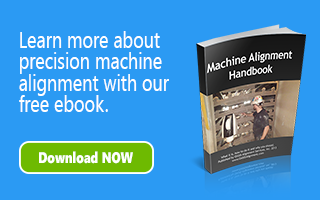In order to produce safe, quality tires, the machines and components that produce the tires must operate to high performance standards. One of the ways that tire manufacturers can ensure their process lines run at optimum efficiency, is to include precision machine alignment inspections and adjustments as part of their regular maintenance plans.
Virtually every component in the tire manufacturing process from the mixers to the curing presses, can benefit from precision machine alignment inspections and/or adjustments. In this post, we provide an overview of tire machine alignment methods and the benefits of alignment in each section of the process.

Precision machine alignment can increase the efficiency of the tire manufacturing process
Mixers
The tire production process starts with raw materials such as natural and synthetic rubber, various chemicals and carbon black. These raw materials are fed into the large mixers where they are combined at high temperatures to form rubber compound which is then milled to form rubber sheets. It is important that upon installation, the mixers be aligned to the centerline of the rest of the manufacturing process. Additionally, drive alignment should be performed by aligning the gearbox to the drive system during gearbox installation or if there are issues with the gearbox.
The rubber sheets are then prepared for components through three processes: extrusion, calendaring and bead building. Precision alignment of the extruders and calendars is critical to the quality of the final product.
Extruders
During the extrusion process, heat and pressure is applied to the rubber compound to produce the rubber components typically used for treads and sidewalls. Maintaining the proper alignment of the rotation center of the screw to the rotation center of the gearbox thrust shaft is a big factor in achieving optimum efficiency. If these components are not aligned, excessive contact may result between the screw and barrel leading to:
• Premature barrel and screw wear
• Increased clearance
• Decreased through-put
• Back-flighting
• Poor mixing
• Screw flex
• Screw breakage
It is highly recommended that extruder inspections include:
• Barrel diametrical profile – wear profile of the barrel
• Screw diametrical profile – wear profile of screw flights
• Barrel to gearbox alignment
• Gearbox to motor alignment
Calenders

Wrinkles and web breaks can be significantly reduced with properly aligned rolls and components.
The rubber sheeting that will be used for the inner plies (carcass) are produced by calendering. In this process, the rubber is squeezed through the calender rolls for uniform caliper and insertion of either fabric or wire cords for maximum strength.
As with most large rolling manufacturing processes, when the rolls and components of the calender are not aligned level to earth and perpendicular to the machine centerline, tire manufactures will begin to see wrinkling and other product defects. Alignment inspections and adjustments of calenders will help to not only decrease wrinkling, but reduce web breaks and improve product tracking. Precision alignment also decreases excessive wear of bearings, bushings and other mechanical parts.
Tire Assembly Machines
Tires are made of many layers of rubber sheet. The building of the tire begins on a revolving drum where the previously calendered fabric, or ply, is wrapped around the drum. Once the appropriate number of plies have been applied to the drum, bead wire is placed on each edge and the belts and tread rubber are applied to form a green tire. In order to produce uniform tires and avoid excess scrap due to trimming, the spindle and winder components of the tire assembly machine should be aligned to the centerline of the machine. Alignment of the tire assembly machines is most critical during installation.
Curing Presses

Precision alignment of curing presses helps to reduce flashing and broken hardware.
Green tires are cured in a vulcanization process where the tires achieve their final shape and other characteristics. The green tire is placed in the curing press where it is pushed into the mold using high heat and pressure.
Due to the excessive pressure involved in this process – whether the presses are clamshell, mechanical or hydraulic, alignment is extremely important. If the two platens are not parallel, tire manufacturers will see broken, damaged or worn mounting hardware. Additionally, when the platens are not properly seated, excessive flashing can occur. Regular alignment inspections are highly recommended to avoid costly quality issues and damaged parts.
ASRS Gantry Crane Rails
Though not officially part of the tire creation process, crane rails are an important part of the shipping and distribution of the finished tires and when not aligned properly, knocks and jumps can occur. Regular inspections of the rails for straightness in both the horizontal and vertical attributes, helps to keep the process running smoothly and reduce premature wear of the rails.
Conclusion
Tire manufacturing equipment runs smoother and more efficiently when components are precisely aligned. Production lines that run at optimum efficiency, see significant increases in uptime and a reduction in waste.
For more educational information on how precision measurement and machine alignment can increase the efficiency of your production lines, please subscribe to our Industry Blog. If you would like to discuss our solutions with an OASIS representative, please contact us today!


George you shared so amazing and quite informative article in this post. I am amazed to read about efficiency about precision machine alignment.Thanks so much George LeGrand for sharing this nice information with us in this post.